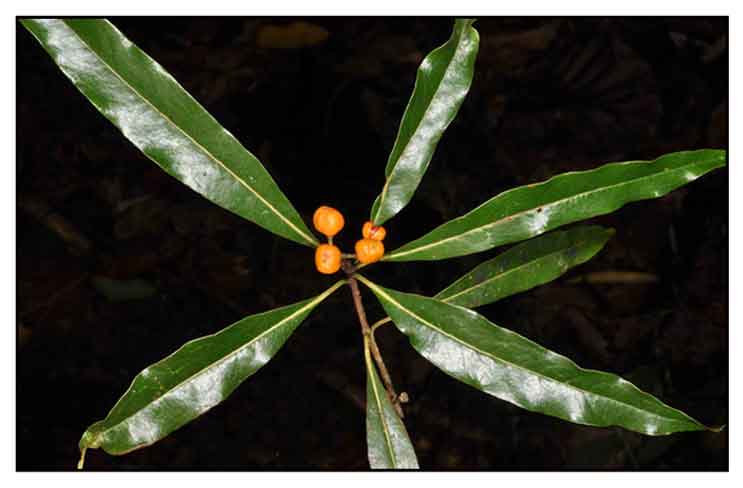|
 Gen info Gen info
- Pittosporaceae is a family made up of 9 genera and about 200 species. The genus Pittosporum comprises about 150 species.
- Etymology: The genus name Pittosporum is derived from the Greek word pittos, meaning "pitch", and sporos meaning "seeds", referring to the black seeds covered with viscid resin (Wagner et al, 1999).
Botany
Mamalis is a tree occasionally reaching heights of 20 meters, although it is usually much smaller. Whole tree is smooth except
for its inflorescence. Leaves are narrowly elliptic, 6 to 15 centimeters long,
and less than 2 centimeters wide, and gradually narrowed at both ends. Flowers
are white, fragrant, about 6 millimeters long, crowded in panicles 5 to 8
centimeters in length. Fruit is small, globular, pale yellow to orange, somewhat rounded when fresh, 6 to 8 millimeters in diameter.
Seeds are about 8, flattened, covered with a glossy red, oily and sticky mucus, with an odor reminiscent of petroleum.
Distribution
- Native to the Philippines.
-
In secondary forests at low and medium altitudes, ascending to 1,400 meters, from northern Luzon to Palawan and Mindanao.
- Also native to Borneo, China, Hainan, Sulawesi, Taiwan, Vietnam.
Constituents
• Fruit yields a volatile oil,
1%; dihydroterpene.
• Leaves yield calcium oxalate and amygdalin.
• Stems yield amygdalin and fats.
• Study yielded two eudesmane-type sesquiterpene glycosides and
the known triterpene betulin. (2)
• Fruits and oil: Fruits are quite small. One tree yields about 16 kilos of fruit which after grinding yields on distillation 21 cubic centimeters of pleasant smelling oil. The oil properties suggests the oil consists principally of the same hydroterpene found in the oil of the petroleum nut. (4)
• Crude extract of leaves yielded alkaloids, triterpenoids, flavonoids, and tannins. (see study below)
(5)
Properties
- Antibacterial, antipyretic.
- Studies have suggested genotoxic, cytotoxic, mutagenic, quorum sensing, clastogenic properties.
Parts used
Leaves, bark, fruit juice.
Uses
Folkloric
- Aromatic decoction of leaves used by women for postpartum baths.
- The Ati tribe in Antique, Philippines use the plant for postpartum care and recovery: leaves and flowers are boiled with Canarium sp., J. gendarussa, C. citratus, Glochidion sp, and Bambusa sp. or C. maxima, a glass of the decoction is drunk and the rest used for bathing.
(8)
- In the Negrito society, bark of P. pentandrum is tied around the neck r woven into a necklace and worn for treating cough and headache.
(9)
-
Decoction of bark used for fever and cough.
- Powdered bark in small doses used as antipyretic.
- Powdered bark also used as febrifuge; in large doses, a general antidote.
-
Also used for bronchitis.
- Decoction of leaves used as aromatic bath after childbirth or
prolonged illness.
- Fruit juice and decoction used for cleansing wounds.
Others
- Wood: Used for jewelry beads; firewood.
- Mamalis oil: Steam distillation of fruits yield a pleasant smelling oil.
Studies
• Genotoxicity: Of 138 Philippine medicinal plant preparations studied,
only 12, including P. pentandrum, exhibited detectable genotoxicity in any system. (1)
• Sesquiterpene Glycosides: Study of chloroform extract yielded two novel eudesmane-type sesquiterpene glycosides and a known triterpene betulin. (2)
• Cytotoxicity / Brine Shrimp Lethality Assay / Leaves: Study evaluated a crude extract of P. pentandrum leaves for in vivo cytotoxic effects against brine shrimp nauplii. Using BSLA, the cytotoxic capability of Mamalis crude extract was evident at 0.01% to 0.09% with LC50 of 0.05%. Results suggest Mamalis crude extract can be further examined as an antimicrobial or antitumor agent. (see constituents above) (5)
• Clastogenicity / Mutagenicity: Leaf and bark decoctions of Pittosporum pentandrum induced frameshift mutagenesis in Salmonella typhimurium. Clastogenicity or chromosome breaking potential was exhibited by decoctions from leaves and bark. (6)
• Quorum Sensing-Mediated α-Hemolysin Inhibition: Study evaluated ten Philippine ethnobotanicals, including Pittosporum pentandrum, for quorum sensing inhibition activity against Staphylococcus aureus PNCM 1582 through α-hemolysin assay after bacterial testing. While quorum sensing inhibition neither kill nor inhibit bacterial growth, QSI drugs hinder signaling and decrease development of resistance, as occurs with antibiotics. All the ethnobotanicals showed inhibition of α-hemolysin indicating quorum sensing inhibition activity. (7)
Availability
Wild-crafted. |


![]()

